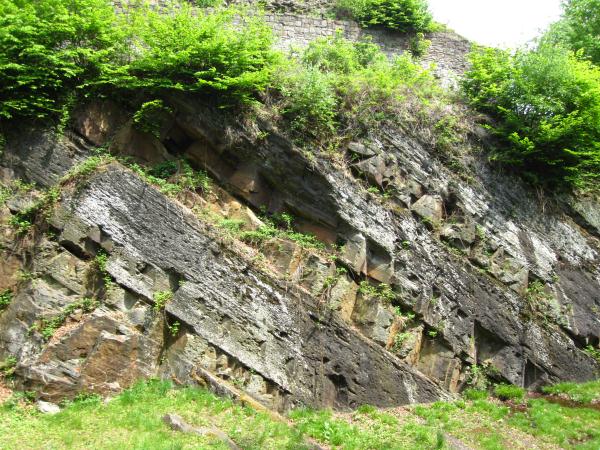Ruhrsandstein auf dem Isenberg EarthCache
Ruhrsandstein auf dem Isenberg
-
Difficulty:
-

-
Terrain:
-

Size:  (not chosen)
(not chosen)
Please note Use of geocaching.com services is subject to the terms and conditions
in our disclaimer.
Ruhrsandstein auf dem Isenberg

Westlich von Hattingen, zieht die Ruhr eine enge Schleife nach Süden hin. Hier erhebt sich der Isenberg.. Seine herausgehobene Lage, die nach 3 Seiten hin steil abfällt, überragt das Ruhrtal um rund 100m.
Die Lage des Isenberg gefiel schon im 12. Jahrhundert dem Herzog von Westfalen. Er ließ auf der Kuppe, die Burg Isenburg errichten, wodurch er leicht den Verkehr im Ruhrtal kontrollieren konnte.
Auf dem Weg zum Sandsteinaufschluss kommt Ihr an den Überresten der Burganlagen vorbei.
Schlieslich erreichen man den tief in den Fels hinein gehauenen Halsgraben der Burg. Er trennt die Burg vom weiterführenden Bergrücken des Isenbergs ab. Heute dient dieser tiefe Einschnitt als Freilichtbühne. Die senkrechte Wand des Grabens liefert uns einen deutlichen Querschnitt durch die harten Bänke des Kaisberg –Sandsteins der mit etwa 50° gegen die Horizontale geneigt ist. Die massiven Sandsteinbänke werden von nur sehr dünnen Tonsteinzwischenlagen getrennt. Hinweise auf Kohleflöze oder auch nur Wurzelböden sind nicht zu erkennen
Der Ruhrsandstein entstand aus Fluss-Sedimenten vor etwa 290 Millionen Jahren im so genannten Namur C, einem Zeitabschnitt des Oberkarbon.
Mehr als 200 Millionen Jahre später wird der oberkarbonische Sandstein durch erneute Bewegungen der Erdkruste und damit verbundener Abtragung darüber liegender Schichten an die Erdoberfläche gehoben. Bekannt als Varizische Faltung.
Unverwitterter Ruhrsandstein ist von hellgrauer bis bläßlich-blaugrauer Farbe. Je offener er den Atmosphärilien ausgesetzt ist, desto intensiver können eisenhaltige Bestandteile wie Siderit und Ankerit mittels Oxidation zu dem Eisenhydroxid Limonit verwittern, welches dem Stein eine gelbliche bis gelblich-braune Farbe verleiht.
Die Menschen zu beiden Seiten des Unter- und Mittellaufs der Ruhr erkannten schon früh die guten Eigenschaften des Sandsteins aus den Schichten des Ruhrkarbons und lernen ihn als Bau- und Werkstein schätzen. Gebäude aus ältester Zeit, wie Kirchen und Brücken hier im Ruhrtal, legen Zeugnis ab von der Beständigkeit des Ruhrsandsteins.
LOGBEDINGUNGEN:
Beantworte folgende Fragen:
Um wieviel Grad ist die Sandsteinschicht zur Horizontalen geneigt?
A = 20°
B = 50°
C = 70°
Unverwitterter Sandstein ist ?
A = gelb bis gelblich-braun
B = dunkelgrau bis schwarz
C = hellgrau bis blaugrau
Schickt Eure Lösungen über den Mailzugang vom Profil.
Wer möchte kann freiwillig ein Foto, von sich oder von seinem GPS mit dem Log hochladen.
ENGLISH:
To the west of Hattingen, where the Ruhr makes a sharp bend to the south, rises Mount Isen. From its outstanding position, dropping away on 3 sides precipitously, the mountain towers 100m over the Ruhr valley.
The Duke of Westphalia liked the position of the Mount Isen back in the 12th century. He had Castle Isen built on the hilltop so he could easily control the traffic in the Ruhr valley.
On the way to the sandstone outcrop you pass the remains of the castle.
Eventually you come to the moat, carved deeply into the cliff and separating the castle from the ridge of Mount Isen, which continues southward. Today this deep incision serves as an open-air stage. The vertical wall of the ditch provides a clear cross section of the hard banks of the Kaisberg Sandstone which lies here at an angle of about 50° to level. The massive banks of sandstone are separated by only a very thin layer of argillite. There are no traces of coal seams or even underclay.
The Ruhr sandstone was formed from river sediments about 290 million years ago in the so-called Namur C, a time period in the Upper Carboniferous.
More than 200 million years later, the Upper Carboniferous sandstone was lifted by renewed movements of the earth's crust and then revealed by subsequent erosion of the Earth's upper layers. Known as a Variscan fold.
Unweathered Ruhr sandstone is light grey to palish-bluish gray in color. The more exposed it is to the atmosphere, the more intense the weathering process (rusting or oxidation) of ferrous components like Siderit and Ankerit. These decompose into iron hydroxide limonite which turns the stone a yellowish to yellowish-brown color.
The people on both sides of the lower and middle reaches of the Ruhr recognized quite early the good qualities of the sandstone from the layers of the Ruhr carbon and came to appreciate it as a building stone and cutting stone. The oldest buildings, like churches and bridges here in the Ruhr valley, are proof of the durability of the Ruhr sandstone.
LOG CONDITIONS:
At approximately which angle are the sandstone layers to level?
A = 20 °
B = 50 °
C = 70 °
Unweathered sandstone is?
A = yellow to yellowish-brown
B = dark grey to black
C = light grey to bluish gray
Send your answers via my geocaching Profile. < br />
+++ Many thanks for the translation => “flusslaufer” +++
Additional Hints
(No hints available.)